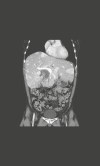Metastatic Pheochromocytomas and Abdominal Paragangliomas
- PMID: 33462603
- PMCID: PMC8063253
- DOI: 10.1210/clinem/dgaa982
Metastatic Pheochromocytomas and Abdominal Paragangliomas
Abstract
Context: Pheochromocytomas and paragangliomas (PPGLs) are believed to harbor malignant potential; about 10% to 15% of pheochromocytomas and up to 50% of abdominal paragangliomas will exhibit metastatic behavior.
Evidence acquisition: Extensive searches in the PubMed database with various combinations of the key words pheochromocytoma, paraganglioma, metastatic, malignant, diagnosis, pathology, genetic, and treatment were the basis for the present review.
Data synthesis: To pinpoint metastatic potential in PPGLs is difficult, but nevertheless crucial for the individual patient to receive tailor-made follow-up and adjuvant treatment following primary surgery. A combination of histological workup and molecular predictive markers can possibly aid the clinicians in this aspect. Most patients with PPGLs have localized disease and may be cured by surgery. Plasma metanephrines are the main biochemical tests. Genetic testing is important, both for counseling and prognostic estimation. Apart from computed tomography and magnetic resonance imaging, molecular imaging using 68Ga-DOTATOC/DOTATATE should be performed. 123I-MIBG scintigraphy may be performed to determine whether 131I-MIBG therapy is a possible option. As first-line treatment in patients with metastatic disease, 177Lu-DOTATATE or 131I-MIBG is recommended, depending on which shows best expression. In patients with very low proliferative activity, watch-and-wait or primary treatment with long-acting somatostatin analogues may be considered. As second-line treatment, or first-line in patients with high proliferative rate, chemotherapy with temozolomide or cyclophosphamide + vincristine + dacarbazine is the therapy of choice. Other therapies, including sunitinib, cabozantinib, everolimus, and PD-1/PDL-1 inhibitors, have shown modest effect.
Conclusions: Metastatic PPGLs need individualized management and should always be discussed in specialized and interdisciplinary tumor boards. Further studies and newer treatment modalities are urgently needed.
Keywords: diagnosis; genetics; histology; imaging; malignant; treatment.
© The Author(s) 2021. Published by Oxford University Press on behalf of the Endocrine Society.
Figures




References
-
- Lenders JW, Duh QY, Eisenhofer G, et al. ; Endocrine Society . Pheochromocytoma and paraganglioma: an endocrine society clinical practice guideline. J Clin Endocrinol Metab. 2014;99(6):1915-1942. - PubMed
-
- Neumann HPH, Young WF Jr, Eng C. Pheochromocytoma and paraganglioma. N Engl J Med. 2019;381(6):552-565. - PubMed
-
- Kiernan CM, Solórzano CC. Pheochromocytoma and paraganglioma: diagnosis, genetics, and treatment. Surg Oncol Clin N Am. 2016;25(1):119-138. - PubMed
-
- Chen H, Sippel RS, O’Dorisio MS, Vinik AI, Lloyd RV, Pacak K; North American Neuroendocrine Tumor Society (NANETS) . The North American Neuroendocrine Tumor Society consensus guideline for the diagnosis and management of neuroendocrine tumors: pheochromocytoma, paraganglioma, and medullary thyroid cancer. Pancreas. 2010;39(6):775-783. - PMC - PubMed
Publication types
MeSH terms
LinkOut - more resources
Full Text Sources
Other Literature Sources
Medical
Research Materials

